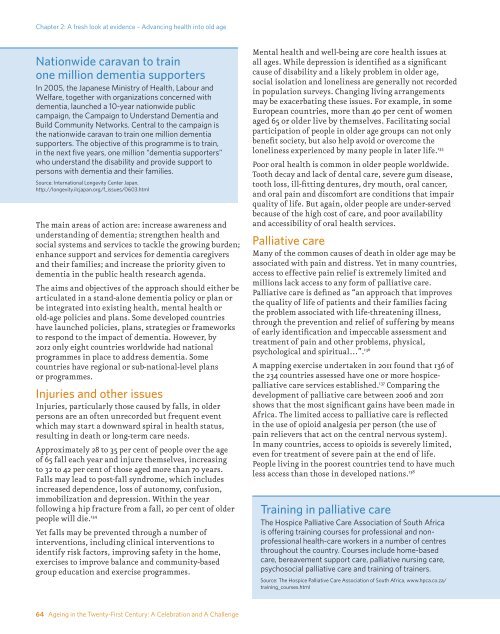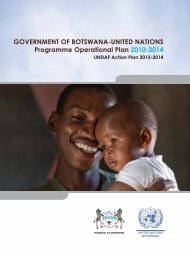Ageing in the Twenty-First Century: - HelpAge International
Ageing in the Twenty-First Century: - HelpAge International
Ageing in the Twenty-First Century: - HelpAge International
Create successful ePaper yourself
Turn your PDF publications into a flip-book with our unique Google optimized e-Paper software.
Chapter 2: A fresh look at evidence – Advanc<strong>in</strong>g health <strong>in</strong>to old age<br />
Nationwide caravan to tra<strong>in</strong><br />
one million dementia supporters<br />
In 2005, <strong>the</strong> Japanese M<strong>in</strong>istry of Health, Labour and<br />
Welfare, toge<strong>the</strong>r with organizations concerned with<br />
dementia, launched a 10-year nationwide public<br />
campaign, <strong>the</strong> Campaign to Understand Dementia and<br />
Build Community Networks. Central to <strong>the</strong> campaign is<br />
<strong>the</strong> nationwide caravan to tra<strong>in</strong> one million dementia<br />
supporters. The objective of this programme is to tra<strong>in</strong>,<br />
<strong>in</strong> <strong>the</strong> next five years, one million “dementia supporters”<br />
who understand <strong>the</strong> disability and provide support to<br />
persons with dementia and <strong>the</strong>ir families.<br />
Source: <strong>International</strong> Longevity Center Japan,<br />
http://longevity.ilcjapan.org/f_issues/0603.html<br />
The ma<strong>in</strong> areas of action are: <strong>in</strong>crease awareness and<br />
understand<strong>in</strong>g of dementia; streng<strong>the</strong>n health and<br />
social systems and services to tackle <strong>the</strong> grow<strong>in</strong>g burden;<br />
enhance support and services for dementia caregivers<br />
and <strong>the</strong>ir families; and <strong>in</strong>crease <strong>the</strong> priority given to<br />
dementia <strong>in</strong> <strong>the</strong> public health research agenda.<br />
The aims and objectives of <strong>the</strong> approach should ei<strong>the</strong>r be<br />
articulated <strong>in</strong> a stand-alone dementia policy or plan or<br />
be <strong>in</strong>tegrated <strong>in</strong>to exist<strong>in</strong>g health, mental health or<br />
old-age policies and plans. Some developed countries<br />
have launched policies, plans, strategies or frameworks<br />
to respond to <strong>the</strong> impact of dementia. However, by<br />
2012 only eight countries worldwide had national<br />
programmes <strong>in</strong> place to address dementia. Some<br />
countries have regional or sub-national-level plans<br />
or programmes.<br />
Injuries and o<strong>the</strong>r issues<br />
Injuries, particularly those caused by falls, <strong>in</strong> older<br />
persons are an often unrecorded but frequent event<br />
which may start a downward spiral <strong>in</strong> health status,<br />
result<strong>in</strong>g <strong>in</strong> death or long-term care needs.<br />
Approximately 28 to 35 per cent of people over <strong>the</strong> age<br />
of 65 fall each year and <strong>in</strong>jure <strong>the</strong>mselves, <strong>in</strong>creas<strong>in</strong>g<br />
to 32 to 42 per cent of those aged more than 70 years.<br />
Falls may lead to post-fall syndrome, which <strong>in</strong>cludes<br />
<strong>in</strong>creased dependence, loss of autonomy, confusion,<br />
immobilization and depression. With<strong>in</strong> <strong>the</strong> year<br />
follow<strong>in</strong>g a hip fracture from a fall, 20 per cent of older<br />
people will die. 134<br />
Yet falls may be prevented through a number of<br />
<strong>in</strong>terventions, <strong>in</strong>clud<strong>in</strong>g cl<strong>in</strong>ical <strong>in</strong>terventions to<br />
identify risk factors, improv<strong>in</strong>g safety <strong>in</strong> <strong>the</strong> home,<br />
exercises to improve balance and community-based<br />
group education and exercise programmes.<br />
Mental health and well-be<strong>in</strong>g are core health issues at<br />
all ages. While depression is identified as a significant<br />
cause of disability and a likely problem <strong>in</strong> older age,<br />
social isolation and lonel<strong>in</strong>ess are generally not recorded<br />
<strong>in</strong> population surveys. Chang<strong>in</strong>g liv<strong>in</strong>g arrangements<br />
may be exacerbat<strong>in</strong>g <strong>the</strong>se issues. For example, <strong>in</strong> some<br />
European countries, more than 40 per cent of women<br />
aged 65 or older live by <strong>the</strong>mselves. Facilitat<strong>in</strong>g social<br />
participation of people <strong>in</strong> older age groups can not only<br />
benefit society, but also help avoid or overcome <strong>the</strong><br />
lonel<strong>in</strong>ess experienced by many people <strong>in</strong> later life. 135<br />
Poor oral health is common <strong>in</strong> older people worldwide.<br />
Tooth decay and lack of dental care, severe gum disease,<br />
tooth loss, ill-fitt<strong>in</strong>g dentures, dry mouth, oral cancer,<br />
and oral pa<strong>in</strong> and discomfort are conditions that impair<br />
quality of life. But aga<strong>in</strong>, older people are under-served<br />
because of <strong>the</strong> high cost of care, and poor availability<br />
and accessibility of oral health services.<br />
Palliative care<br />
Many of <strong>the</strong> common causes of death <strong>in</strong> older age may be<br />
associated with pa<strong>in</strong> and distress. Yet <strong>in</strong> many countries,<br />
access to effective pa<strong>in</strong> relief is extremely limited and<br />
millions lack access to any form of palliative care.<br />
Palliative care is def<strong>in</strong>ed as “an approach that improves<br />
<strong>the</strong> quality of life of patients and <strong>the</strong>ir families fac<strong>in</strong>g<br />
<strong>the</strong> problem associated with life-threaten<strong>in</strong>g illness,<br />
through <strong>the</strong> prevention and relief of suffer<strong>in</strong>g by means<br />
of early identification and impeccable assessment and<br />
treatment of pa<strong>in</strong> and o<strong>the</strong>r problems, physical,<br />
psychological and spiritual…”. 136<br />
A mapp<strong>in</strong>g exercise undertaken <strong>in</strong> 2011 found that 136 of<br />
<strong>the</strong> 234 countries assessed have one or more hospicepalliative<br />
care services established. 137 Compar<strong>in</strong>g <strong>the</strong><br />
development of palliative care between 2006 and 2011<br />
shows that <strong>the</strong> most significant ga<strong>in</strong>s have been made <strong>in</strong><br />
Africa. The limited access to palliative care is reflected<br />
<strong>in</strong> <strong>the</strong> use of opioid analgesia per person (<strong>the</strong> use of<br />
pa<strong>in</strong> relievers that act on <strong>the</strong> central nervous system).<br />
In many countries, access to opioids is severely limited,<br />
even for treatment of severe pa<strong>in</strong> at <strong>the</strong> end of life.<br />
People liv<strong>in</strong>g <strong>in</strong> <strong>the</strong> poorest countries tend to have much<br />
less access than those <strong>in</strong> developed nations. 138<br />
Tra<strong>in</strong><strong>in</strong>g <strong>in</strong> palliative care<br />
The Hospice Palliative Care Association of South Africa<br />
is offer<strong>in</strong>g tra<strong>in</strong><strong>in</strong>g courses for professional and nonprofessional<br />
health-care workers <strong>in</strong> a number of centres<br />
throughout <strong>the</strong> country. Courses <strong>in</strong>clude home-based<br />
care, bereavement support care, palliative nurs<strong>in</strong>g care,<br />
psychosocial palliative care and tra<strong>in</strong><strong>in</strong>g of tra<strong>in</strong>ers.<br />
Source: The Hospice Palliative Care Association of South Africa, www.hpca.co.za/<br />
tra<strong>in</strong><strong>in</strong>g_courses.html<br />
64 <strong>Age<strong>in</strong>g</strong> <strong>in</strong> <strong>the</strong> <strong>Twenty</strong>-<strong>First</strong> <strong>Century</strong>: A Celebration and A Challenge







